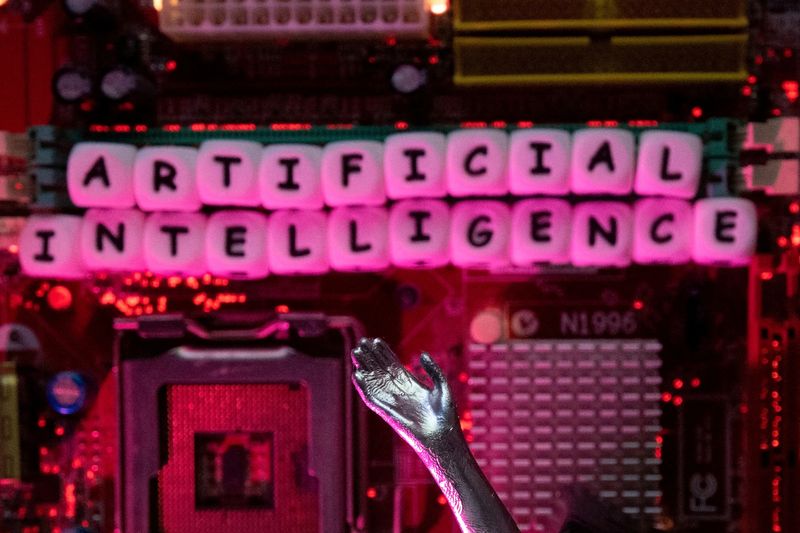By Karen Freifeld
(Reuters) - The U.S. government said on Monday it would issue a new regulation designed to control access to U.S.-designed artificial intelligence chips and technology by other countries around the world.
The rule regulates the flow of American AI chips and technology needed for the most sophisticated AI applications.
Here are more details on the U.S. action:
WHICH CHIPS ARE RESTRICTED?
The rule restricts the export of chips known as graphics processing units (GPUs), specialized processors originally created to accelerate graphics rendering.
Although known for their role in gaming, the ability of GPUs such as those made by U.S.-based industry leader Nvidia (NASDAQ:NVDA) to process different pieces of data simultaneously has made them valuable for training and running AI models.
OpenAI's ChatGPT, for example, is trained and improved on tens of thousands of GPUs.
The number of GPUs needed for an AI model depends on how advanced the GPU is, how much data is being used to train the model, the size of the model itself and the time the developer wants to spend training it.
WHAT IS THE U.S. DOING?
To control global access to AI, the U.S. is expanding restrictions on advanced GPUs needed to build the clusters used to train advanced AI models.
The limits on GPUs for most countries in the new rule are set by compute power, to account for differences in individual chips.
Total (EPA:TTEF) processing performance (TPP) is a metric used to measure the computational power of a chip. Under the regulation, countries with caps on compute power are restricted to a total of 790 million TPP through 2027.
The cap translates into the equivalent of nearly 50,000 H100 Nvidia GPUs, according to Divyansh Kaushik, an AI expert at Beacon Global Strategies, a Washington-based advisory firm.
"Fifty thousand H100s is an enormous amount of power - enough to fuel cutting-edge research, run entire AI companies or support the most demanding AI applications on the planet," he said.
Those could include running a global-scale chatbot service or managing advanced real-time systems like fraud detection or personalized recommendations for massive companies like Amazon (NASDAQ:AMZN) or Netflix (NASDAQ:NFLX), Kaushik added.
But the caps do not reflect the true limit on the number of H100 chips in a country. Companies like Amazon Web Services or Microsoft (NASDAQ:MSFT)'s Azure cloud unit that meet the requirements for special authorizations - also known as "Universal Verified End User" status - are exempt from the caps.
National authorizations also are available to companies headquartered in any destination that is not a "country of concern." Those with national Verified End User status have caps of roughly 320,000 advanced GPUs over the next two years.
"The country caps are specifically designed to encourage companies to secure Verified End User status," Kaushik said, providing greater visibility to U.S. authorities about who is using them and helping to prevent GPUs from being smuggled into China.
ARE THERE OTHER EXCEPTIONS TO THE LICENSING?
Yes. If a buyer orders small quantities of GPUs - the equivalent of up to some 1,700 H100 chips - they will not count toward the caps, and only require government notification, not a license.
Most chip orders fall below the limit, especially those placed by universities, medical institutions, and research organizations, the U.S. said. This exception is designed to accelerate low-risk shipments of U.S. chips globally.
There also are exceptions for GPUs for gaming.
WHICH PLACES CAN GET UNLIMITED AI CHIPS?
Eighteen destinations are exempt from country caps on advanced GPUs, according to a senior administration official.
Those are Australia, Belgium, Britain, Canada, Denmark, Finland, France, Germany, Ireland, Italy, Japan, the Netherlands, New Zealand, Norway, South Korea, Spain, Sweden and Taiwan plus the United States.
WHAT IS BEING DONE WITH 'MODEL WEIGHTS'?
Another item being controlled by the U.S. is known as "model weights." AI models are trained to produce meaningful material by being fed large quantities of data. At the same time, algorithms evaluate the outputs to improve the model's performance.

The algorithms adjust numerical parameters that weigh the results of certain operations more than others to better complete tasks. Those parameters are model weights. The rule sets security standards to protect the weights of advanced "closed-weight", or non-public, models.
Overall, Kaushik said, the restrictions are aimed at ensuring the most advanced AI is developed and deployed in trusted and secure environments.